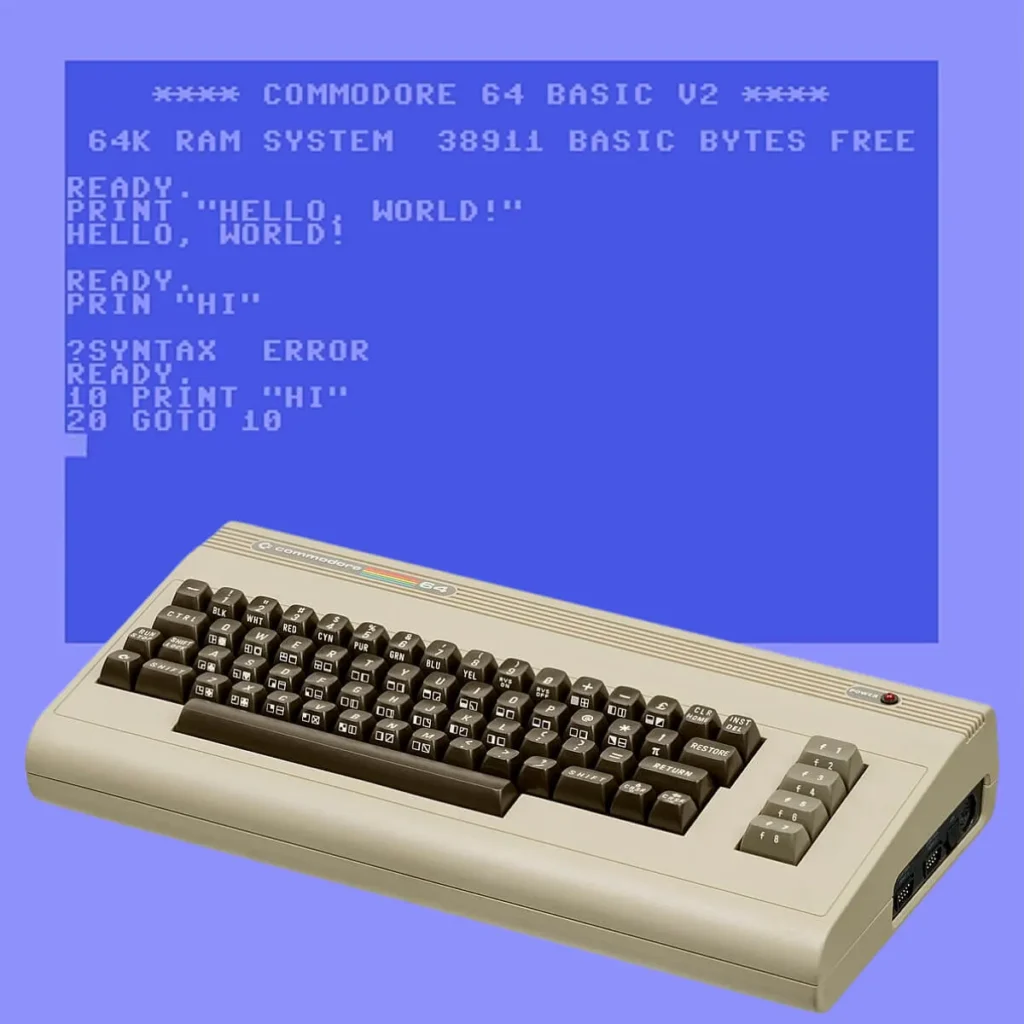A Brief History of the C64

The Commodore 64 (C64) is one of the most iconic home computers in history, known for its impact on the personal computing and gaming industries. Here’s a brief history of the C64:
Introduction and Development (1981 – 1982)
- Commodore International was a company well-known for producing calculators and early personal computers. By the early 1980s, it was vying for market share in the rapidly growing personal computer market.
- The C64 was introduced in 1982. Its design was overseen by Commodore’s chief engineer Robert Russell, who helped create a machine that would appeal to home users, gamers, and hobbyists alike.
- It featured a 40-character by 25-line display, and its most impressive feature was the MOS Technology 6510 microprocessor, running at 1.023 MHz (PAL) or 0.985 MHz (NTSC).
- The computer came with 64KB of RAM, which was a substantial amount for its time and gave the system its name (Commodore 64).
Key Features
- Graphics: The C64 had a VIC-II graphics chip, which allowed for a wide range of colors (16 in total) and advanced sprite capabilities that made it a favorite among game developers.
- Sound: It also had the SID (Sound Interface Device) chip, one of the most advanced audio processors in its class. The SID chip allowed the C64 to produce rich, complex music and sound effects, contributing to its popularity in gaming.
- Storage: The system typically used floppy disk drives (1541 disk drive) or cassette tapes for data storage, though the speed of these storage mediums was relatively slow by modern standards.
Success in the Market (1982 – 1986)
- The Commodore 64 was priced competitively at around $595 at launch (roughly $1,500 in today’s money). It was marketed as an affordable home computer, appealing to both educational markets and consumers looking for entertainment.
- In the mid-1980s, the C64’s success surged due to its large library of software, including thousands of games, productivity tools, and educational programs. The system became extremely popular with home users, particularly for gaming.
- The C64 dominated the personal computer market in the mid-1980s, frequently outselling other computers like the Apple II, Atari 8-bit series, and ZX Spectrum. It’s estimated that over 17 million units were sold worldwide, making it one of the best-selling personal computers of all time.
Legacy in Gaming
- The Commodore 64 became a powerhouse in the gaming world, with thousands of titles created for the platform, many of which became classics. Iconic games like “The Bard’s Tale,” “Elite,” “Impossible Mission,” “Pitfall II,” and “Summer Games” were released on the C64, showcasing the power of the system’s hardware.
- The SID chip also gained legendary status due to its sound capabilities, and many composers, such as Rob Hubbard and Martin Galway, became famous for their contributions to the C64’s soundtracks.
Decline (1986 – 1993)
- By the late 1980s, the IBM PC compatibles and the Apple Macintosh were gaining ground in the personal computing space, offering more advanced hardware and a growing software ecosystem.
- In 1989, Commodore released the C64c, a more compact version of the original C64, but it didn’t stop the decline in the C64’s market dominance.
- Despite attempts to revive the system with the C128 (released in 1985), which offered backward compatibility with the C64, the world was moving toward more powerful and versatile systems.
End of Production (1993)
- The Commodore 64 was officially discontinued in 1993, after more than a decade of success. By that time, the market had shifted to new computers with more advanced graphics, processing power, and capabilities.
- The end of production didn’t mark the end of the C64’s legacy, though.
Afterlife and Legacy
- Emulation: The C64 has continued to live on through emulators, which have allowed fans to experience its games and software on modern computers and smartphones.
- C64 Mini: In 2018, a miniaturized version of the C64, called the Commodore 64 Mini, was released. It was a plug-and-play device with preloaded games, bringing the nostalgia of the C64 back to a new generation of players.
- Cultural Impact: The C64 is widely regarded as one of the most influential home computers of the 1980s. It played a huge role in bringing personal computing and gaming into millions of homes and provided a foundation for future developments in both industries.
The Commodore 64 is remembered as a beloved classic, blending power, affordability, and an unforgettable library of games and software that made it a household name in its prime.